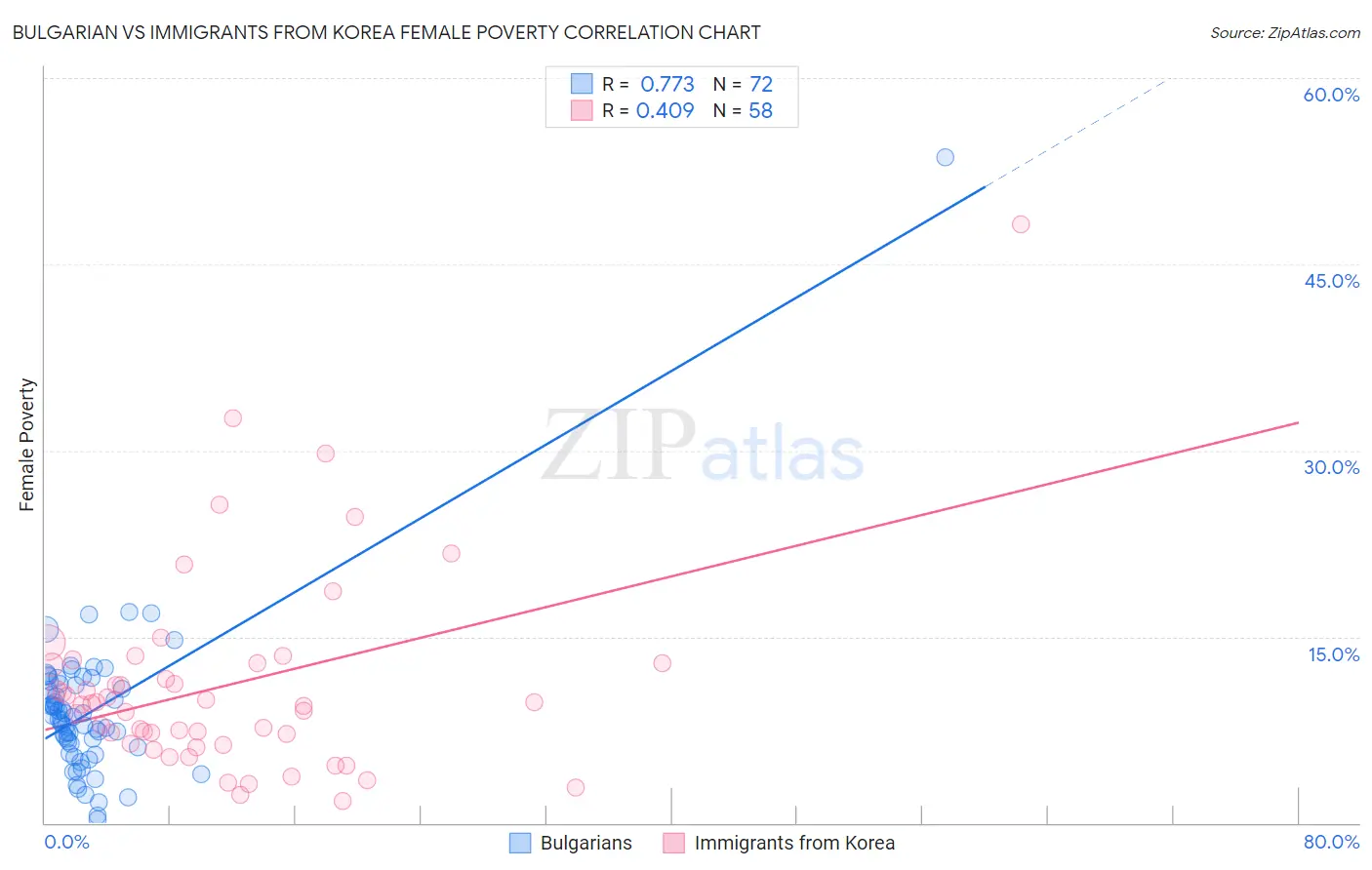Bulgarian vs Immigrants from Korea Female Poverty
COMPARE
Bulgarian
Immigrants from Korea
Female Poverty
Female Poverty Comparison
Bulgarians
Immigrants from Korea
11.1%
FEMALE POVERTY
99.9/ 100
METRIC RATING
9th/ 347
METRIC RANK
11.7%
FEMALE POVERTY
99.6/ 100
METRIC RATING
28th/ 347
METRIC RANK
Bulgarian vs Immigrants from Korea Female Poverty Correlation Chart
The statistical analysis conducted on geographies consisting of 205,544,553 people shows a strong positive correlation between the proportion of Bulgarians and poverty level among females in the United States with a correlation coefficient (R) of 0.773 and weighted average of 11.1%. Similarly, the statistical analysis conducted on geographies consisting of 415,882,145 people shows a moderate positive correlation between the proportion of Immigrants from Korea and poverty level among females in the United States with a correlation coefficient (R) of 0.409 and weighted average of 11.7%, a difference of 4.9%.

Female Poverty Correlation Summary
| Measurement | Bulgarian | Immigrants from Korea |
| Minimum | 0.25% | 1.7% |
| Maximum | 53.6% | 48.2% |
| Range | 53.3% | 46.5% |
| Mean | 9.0% | 11.1% |
| Median | 8.5% | 9.6% |
| Interquartile 25% (IQ1) | 6.2% | 6.4% |
| Interquartile 75% (IQ3) | 11.1% | 12.8% |
| Interquartile Range (IQR) | 4.9% | 6.5% |
| Standard Deviation (Sample) | 6.5% | 8.1% |
| Standard Deviation (Population) | 6.4% | 8.1% |
Demographics Similar to Bulgarians and Immigrants from Korea by Female Poverty
In terms of female poverty, the demographic groups most similar to Bulgarians are Immigrants from South Central Asia (11.1%, a difference of 0.19%), Immigrants from Hong Kong (11.2%, a difference of 0.80%), Maltese (11.2%, a difference of 0.91%), Bhutanese (11.3%, a difference of 1.4%), and Immigrants from Lithuania (11.3%, a difference of 1.4%). Similarly, the demographic groups most similar to Immigrants from Korea are Iranian (11.7%, a difference of 0.21%), Immigrants from Northern Europe (11.6%, a difference of 0.32%), Croatian (11.6%, a difference of 0.32%), Luxembourger (11.6%, a difference of 0.59%), and Burmese (11.6%, a difference of 0.61%).
| Demographics | Rating | Rank | Female Poverty |
| Immigrants | South Central Asia | 99.9 /100 | #8 | Exceptional 11.1% |
| Bulgarians | 99.9 /100 | #9 | Exceptional 11.1% |
| Immigrants | Hong Kong | 99.9 /100 | #10 | Exceptional 11.2% |
| Maltese | 99.9 /100 | #11 | Exceptional 11.2% |
| Bhutanese | 99.9 /100 | #12 | Exceptional 11.3% |
| Immigrants | Lithuania | 99.9 /100 | #13 | Exceptional 11.3% |
| Lithuanians | 99.8 /100 | #14 | Exceptional 11.4% |
| Latvians | 99.8 /100 | #15 | Exceptional 11.4% |
| Immigrants | Bolivia | 99.8 /100 | #16 | Exceptional 11.5% |
| Bolivians | 99.8 /100 | #17 | Exceptional 11.5% |
| Immigrants | Scotland | 99.8 /100 | #18 | Exceptional 11.5% |
| Norwegians | 99.8 /100 | #19 | Exceptional 11.5% |
| Eastern Europeans | 99.7 /100 | #20 | Exceptional 11.5% |
| Italians | 99.7 /100 | #21 | Exceptional 11.6% |
| Swedes | 99.7 /100 | #22 | Exceptional 11.6% |
| Burmese | 99.7 /100 | #23 | Exceptional 11.6% |
| Luxembourgers | 99.7 /100 | #24 | Exceptional 11.6% |
| Immigrants | Northern Europe | 99.6 /100 | #25 | Exceptional 11.6% |
| Croatians | 99.6 /100 | #26 | Exceptional 11.6% |
| Iranians | 99.6 /100 | #27 | Exceptional 11.7% |
| Immigrants | Korea | 99.6 /100 | #28 | Exceptional 11.7% |